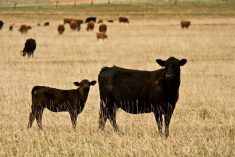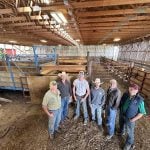Compared to last week, western Canadian yearling prices were $1-$4 higher on average; calves were steady to $2 higher. Limited volume of calves under 600 lbs. made the market hard to define; however, strong demand was surfacing across all weight categories.
The weaker Canadian dollar, along with stronger live cattle futures, set a positive tone. Buyers didn’t flinch when feeder cattle futures faltered late in the week. This weakness was viewed as a temporary hiccup with very speculative liquidation. Saskatchewan and Manitoba have experienced favourable rains over the past month. Southern Alberta is on the drier side but this is optimal for feedlot pen conditions. Weather appears to be underpinning the feeder market with ideas of larger barley production adding fuel to buying interest. Backgrounders were picking away at small bunches but even late-blooming stragglers were well bid. It’s that time of year when the scarcity issue comes into play.
Read Also

U.S. grains: Soy hits four-month high on hopes for China trade deal
U.S. soybean futures jumped to their highest level in more than four months on Monday on hopes that China will resume buying American supplies after President Donald Trump said the countries were set to reach a trade deal during his trip to Asia this week.
In east-central Alberta, black Angus-based steers weighing a hair over 900 lbs. dropped the gavel at $191; Speckle-based steers weighing 940 lbs. were quoted at $182 and tan mixed heifers averaging 865 lbs. were valued at $173. Black steers weighing 800 lbs. reached up to $204 and 790-lb. heifers sold for $191. These thinner, medium- to larger-frame cattle were/are in high demand. Once again we saw Saskatchewan cattle producers shipping in cattle to this crowd.
South of Edmonton, black steers weighing 820 lbs. were quoted at $196 and similar-quality heifers weighing 790 lbs. were reported at $176. Prices were quite variable within a short radius but buyers are valuing every characteristic. In southern Alberta, a small package of Simmental-based 715-lb. steers were valued at $220 landed in the feedlot. Mixed medium-frame heifers averaging 720 lbs. were quoted at $183. The heifer discount widened in the lighter weight categories.
Alberta packers were buying fed cattle in the range of $275-$277 delivered, up $1-$2 from seven days earlier. Feeding margins are in positive territory if the feedlot booked its feed grains earlier. U.S. feeder prices in Oklahoma City were $4-$7 higher. The Canadian market is functioning to ration demand by trading at premium to U.S. values, thereby encouraging imports and slowing exports.
— Jerry Klassen manages the Canadian office of Swiss-based grain trader GAP SA Grains and Produits Ltd. and is president and founder of Resilient Capital, specializing in proprietary commodity futures trading and market analysis. Jerry consults with feedlots on risk management and writes a weekly cattle market commentary. He can be reached at 204-504-8339 or via his website at ResilCapital.com.













